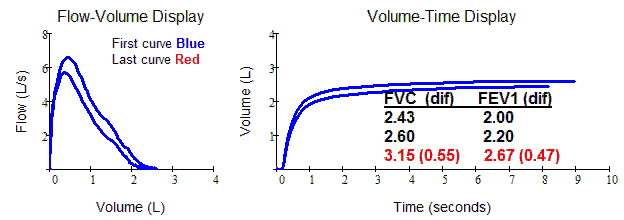
Incomplete Inhalation
The two most common problems are a lack of a complete inhalation and failure to forcefully exhale at the start of the maneuver. The corresponding coaching instructions are "take a deeper breath in" and "blast the air out at first."
The figure below shows a test with 3-curves. The last maneuver is much larger because of a deeper inhalation and is not a repeatable test. You should coach take a deeper breath. An incomplete inhalation can mimic a restrictive lung disease pattern, so it is particularly important that a complete inhalation be obtained before the forced exhalation. With the larger curve, the other two curves are not acceptable and the test is not repeatable. So, another maneuver should be obtained, again coaching take in a deeper breath.

Poor Initial Effort Top
In the next example below, the first two curves (blue) have low peak flows due to a lack of an initial maximal exhalation. The peak flows are obviously lower than the maximal peak flow (red curve). Also, as a general rule, the peak flows should be twice the observed FVC. In this example, the two peak flows (blue) are less than half the value of the FVC.
The last curve (red) has much larger flow rates, particularly at the beginning of the maneuver, due to a maximal forced exhalation. So, you need to coach blast the air out at first.
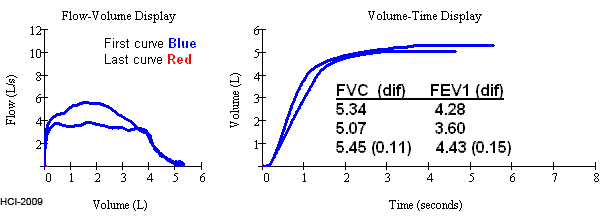
Abrupt Termination Top
In the example below, four maneuvers were obtained. The first three curves have an abrupt termination which results in significantly lower FVCs. The last curve in red is an acceptable FVC maneuver where the FVC is 0.48 liters higher than the largest of the previous 3-unacceptable maneuvers. If the last curve (red) had not been obtained, this subject may have been inappropriately classified as having a restrictive lung disease pattern due to a low FVC. The last acceptable curve can usually be obtained by insuring the subject's tongue is not being place in the mouthpiece or asking the subject to sustain his/her effort at the end of the maneuver by continuing to forcefully exhale. Sometimes a reflex closure of the glottis can cause an abrupt termination as seen below. If so, have the subject relax or even not try quite has hard to forcefully exhale to prevent glottis closure.
Technically, the test session below is not a valid test session as the FVC is not repeatable. So, two additional maneuvers are needed.
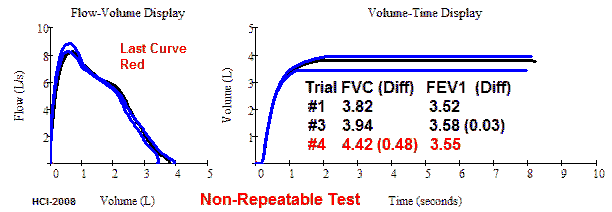
Extra Breath Top
In the final invalid test example, the subject takes in an extra-breath at the end of the maneuver. He is able to do so because a nose-clip is not used. The extra-breath results in a falsely higher FVC; and therefore, a falsely lower FEV1/FVC% sometimes below the lower limit of normal. So, this subject is incorrectly classified as having airways obstruction and in some studies may incorrectly receive a bronchodilator. Therefore, it is important that maneuvers with extra-breaths be recognized and deleted and a nose-clip be used to avoid an incorrect interpretation.
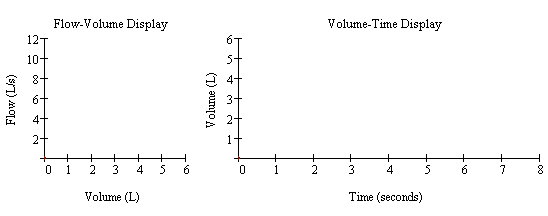
Valid Test Top
Perhaps it is useful to review the characteristics of a good or valid test. Below is a valid test with three acceptable maneuvers and a repeatable FVC and FEV1.
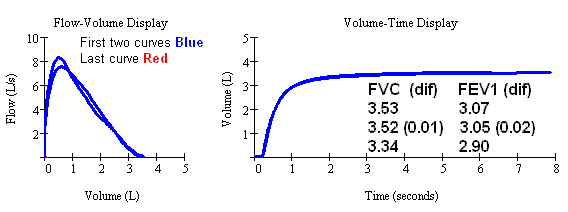
Notice in the above example that there are three acceptable curves -- curves with a good peak flow, a smooth continuous effort, more than six seconds of exhalation, and a plateau in the volume-time curve. In addition to the FVC and FEV1 being repeatable to within 0.02 liters (well within the 0.15 liter requirement), the flow-volume and volume-time curves are essentially the same. Achieving the same size and shape of flow-volume and volume-time curves indicates that a maximum inhalation occurred and flow limitation, because of a maximal effort, was achieved. The last curve (red) is slightly lower, probably due to a slightly less inhalation, but it is not low enough to be unacceptable due to an incomplete inhalation.
Repeatable Poor Effort Top
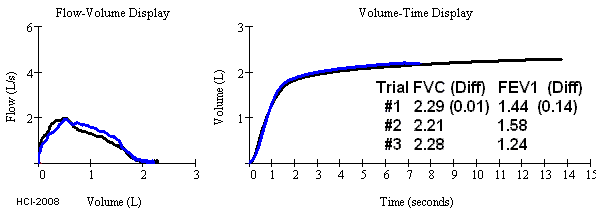
Notice in the above example that there are three very repeatable curves as are the corresponding FVC and FEV1 values. The FEV1 and FEV1/FVC% are below the lower limit of normal (LLN) suggesting an obstructive lung disease pattern. However, the peak flows are very low and the flow-volume curves are rounded with no sharp peak (see flow-volume curves). In general, the peak flow values should be approximately twice the FVC value but in this case they are both about 2. Therefore, it is very likely that the reduced FEV1 values are due to a poor start of test effort. So, you should obtain additional maneuvers while coaching BLAST the air out at first. This example illustrates the importance of closely reviewing the curves even when the computer may conclude it is a valid test (repeatable test with three acceptable maneuvers).
Hankinson Consulting, Inc. 2009 Revised 9/10/2016